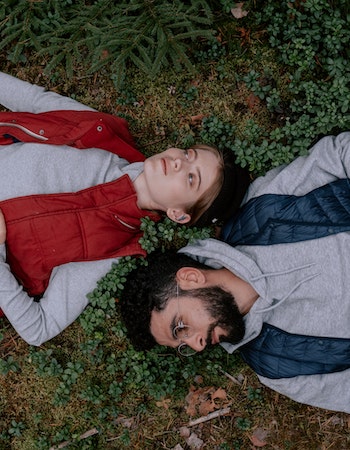Together For A Day
Stories similar to this that you might like too.
“I’m sorry,” I said, “but you’re going to have to wait.” The woman looked at me with a confused expression. She was in her late twenties or early thirties and had long black hair that fell down past the middle of her back; she wore it tied up into two neat braids on either side of her head like an Indian princess from some old movie about ancient India.
Her eyes were large and dark brown—the color of coffee beans. They seemed almost too big for her face, which was round but not fat by any means: just right proportioned overall. And then there’s this little thing…
She wasn’t wearing much makeup except a touch around her lips and under her eyes where they would naturally be puffy after crying so hard all day yesterday. That made sense because she’d been weeping nonstop since we met last night outside my apartment building when I came home from work.
It took us until nearly midnight before someone finally let her inside the front door of one of those high-rise buildings near downtown Seattle called One Magnolia Place. Then another hour passed while she cried herself out over what happened to her husband who worked as a computer programmer at Microsoft.
He didn’t come home last Thursday evening and his car remained parked in its usual spot outside their condo unit in Redmond, Washington. His cell phone rang several times throughout Friday afternoon without anyone picking up, and he hadn’t answered any messages left on voicemail.
By Saturday morning, no one could get hold of him, including his wife, whose name is Jenny. So now here she stood looking at me through teary eyes asking if I knew anything about why her husband might’ve disappeared.
The truth was, I did know something about it. But first things first. There are certain rules that must always be followed whenever dealing with people experiencing emotional trauma such as grief or shock, especially when trying to help them move forward toward healing.
When meeting new clients, I usually ask how many hours per week they spend watching television. What type of shows does each person watch most often during prime time (7–10 PM)? Do these individuals prefer comedy programs, dramas, reality TV, talk show hosts, game shows, news magazines, sports events, crime stories involving serial killers and other psychopaths, medical mysteries featuring doctors performing heroic acts against impossible odds, historical documentaries about famous battles fought between armies of knights wielding swords and lances, science fiction movies showing space aliens invading Earth, etc.?
How important is religion in their lives? Are they Christians, Jews, Muslims, Buddhists, Hindus, atheists, agnostics, members of cult groups, or none of the above? Does everyone in the family share similar religious beliefs? If not, can they tolerate differences among themselves regarding faith? Is there any history of mental illness within the immediate bloodline?
These questions allow me to determine whether every member of the household has good moral character, compassion for others, excellent communication skills, strong self-esteem, healthy coping mechanisms, and the ability to make sound decisions based on logic rather than emotion or intuition.
In short, it allows me to ascertain whether they will likely follow the advice given to them by the therapist hired to provide professional assistance. This particular client had already proven herself fit enough to take charge of her own life despite having suffered through numerous traumas in the past.
Even though she appeared slightly disheveled today due mostly to lack of sleep following endless days spent searching for her missing spouse, she still carried an air of confidence and pride that radiated from deep within. Plus, she possessed both intelligence and common sense, qualities rarer than precious gems to find nowadays.
“That sounds reasonable,” she agreed. “So what exactly am I supposed to do?” she asked again, referring to my instructions pertaining to the reason behind her current visit. We’d talked extensively on the telephone prior to arriving at my office, so she should understand everything that needed to happen next.
After gathering a few personal items together—a purse containing cash and credit cards along with her identification papers, keys, and other necessary documents—she followed me into a private room furnished only with three small tables painted white and topped with red cloths.
She sat across from me at the far end of one table. As soon as she lowered herself onto the chair provided for her comfort, she started sobbing once more. A tissue box rested atop a nearby wooden surface.
Using two fingers, I placed my index finger on top of mine and held them loosely joined. Noting this gesture, she nodded yes to indicate understanding. The idea was to put our hands together like claspers used by wrestlers in the ring before starting a match, which meant sharing emotions openly with each other right then and there.
I closed my eyes briefly and breathed deeply into my nostrils, inhaling and exhaling slowly, picturing myself surrounded by blue sky, green grass, clean water, tall trees, gentle breezes rustling leaves, sunlight dappled through branches, birds singing sweetly, squirrels scampering effortlessly through treetops, flowers blooming brightly everywhere, deer grazing peacefully beneath the shade of old oak trees…and all creatures living harmoniously with one another.
While enjoying this peaceful setting, I thought back to childhood memories growing up in rural Kentucky where our house stood on five acres amid towering oaks draped heavily with Spanish moss hanging down low over ancient pecan tree limbs swaying gently in summertime winds.
My father was a farmer who loved nature’s bounty even though he never attended college; therefore, I was raised free-spirited by parents devoted to simple values: hard work, honesty, integrity, loyalty, kindness, generosity, responsibility, love of God, and country, patriotism, respect for authority figures, and education were all instilled within me early in childhood without ever being specifically taught.
Those lessons came naturally because we lived outside town limits way out beyond the county line where folks didn’t have much money but shared plenty of love for their kids, cousins, uncles, aunts, neighbors, and everybody else around them.
Life seemed simpler then. Unfortunately, society moved away from those basic principles long ago. Nowadays, greed and materialism rule supreme while human decency seems to have been lost somewhere along the way.
After taking several deep breaths, I opened my eyes and looked directly at Mary Jane Sullivan sitting opposite me. “Do you remember the day when your husband first told his mother that he wanted to marry someone named Barbara Whitehead instead of you? When did that conversation occur?
Was it shortly after he graduated high school or later, perhaps right around the time he entered college?”
Mary Jane wiped tears off her cheeks with the tissue she offered as she answered. “He said something to Mom about wanting a career change.”
“What kind of job would that be?”
She blinked a couple times, thinking carefully about how best to answer. “A pilot maybe. He always liked airplanes and flying.”
“Did Dad know anything specific about why John wanted to leave home for California, particularly since it wasn’t very close to here?”
“Not really. It just sounded like he couldn’t wait to get out there. And to think, now look what happened! What are we going to do now?”
“You’re probably wondering if he’ll come back alive someday, aren’t you? Or is death preferable to continuing to live knowing he might not walk through the front door anytime soon or ever again? Did he say anything to make you believe he knew he wouldn’t survive whatever danger lurked ahead of him in Los Angeles?”
Again Mary Jane shook her head no. Her response surprised me considering recent events surrounding yet another disappearance. Yet, she remained steadfast in believing her husband had survived somehow.
That made perfect sense to me based on her earlier statements regarding the depth of love between them. Other than having met her son-in-law recently during a family function celebrating his graduation, she’d known nothing whatsoever about him until he proposed marriage seven short months beforehand.
This woman was still in denial despite knowing firsthand knowledge of the tragedy striking her daughter and granddaughter. There could also be some guilt involved given the fact that Mr. Sullivan apparently sought out Barbara Whitehead rather than pursuing an ongoing relationship with Mary Jane.
I sensed her husband would have handled things differently if he hadn’t already fallen madly in love with another female.
It occurred to me that Mary Jane may have lied about finding a note written by her deceased husband, especially if the content related to information involving Barbara Whitehead. Instead, she found a letter addressed simply to ‘Mom’ from somebody claiming they owed John $500 and needed help raising funds immediately so he could pay off his loan balance.
If true, this person must have intended to betray Barbara’s trust by helping her hide evidence revealing everything Mr. Sullivan was doing behind her back prior to his death. In turn, John likely discovered Barbara’s deception via intercepted telephone calls and emails which ultimately led to their murder.
The only question remaining was whether whoever wrote this message planned to kill both women simultaneously once and for all or, alternatively, continue playing games waiting until each eventually died separately.
Either scenario appeared possible under certain circumstances although eliminating Barbara before killing herself posed more immediate risks including the chance of being identified as the perpetrator regardless of motive, opportunity, and circumstance.
A previous attempt at using poison proved unsuccessful due to its odor becoming quickly apparent forcing the murderer to resort to other means such as strangling Mrs. Whitehead and smothering little Michael.
But again, the presence of bloodstains inside the apartment meant the killer had placed himself in harm’s way while committing these brutal acts against two individuals who could easily identify him or her. After careful consideration of all available facts, I suspected this unknown individual used the same gun to shoot John and Michael.
Therefore, nobody besides the perpetrator should possess physical evidence linking the murders together, except possibly one thing…an unidentified piece of jewelry belonging to neither victim. However, I doubted the necklace held any useful clues and therefore decided to move forward by focusing on obtaining further details concerning the mysterious identity of this man or woman responsible for murdering three people in less than six weeks.
My next step would involve trying to locate Barbara Whitehead or, failing that, obtaining additional information pertaining to the whereabouts of Catherine O’Toole’s remains. For the moment, however, I felt compelled to focus entirely on identifying the unknown murderer without placing unnecessary pressure upon anyone else involved beyond the victims themselves and their respective families.
While I understood the need to bring closure to those affected by this terrible crime, I considered it equally important to prevent future tragedies from occurring elsewhere unless absolutely necessary. Without a doubt, the lives of countless others were at stake depending upon where the unknown assailant ended up heading next.
The End


